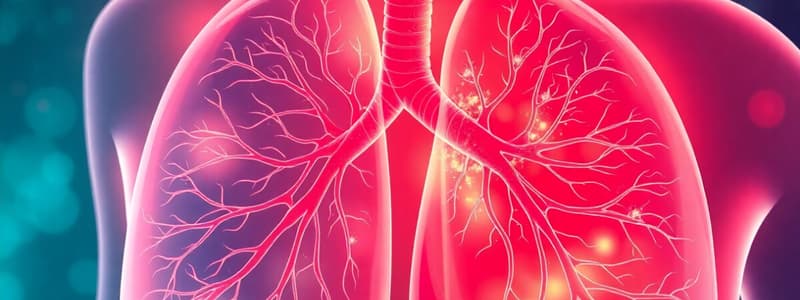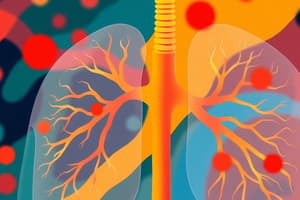Podcast
Questions and Answers
Which receptor primarily mediates bronchoconstriction in the lungs?
Which receptor primarily mediates bronchoconstriction in the lungs?
- M1 receptor
- M2 receptor
- M4 receptor
- M3 receptor (correct)
What effect does stimulation of M2 receptors have on acetylcholine secretion?
What effect does stimulation of M2 receptors have on acetylcholine secretion?
- It stimulates further secretion of acetylcholine.
- It inhibits the secretion of acetylcholine. (correct)
- It has no effect on acetylcholine secretion.
- It promotes bronchoconstriction.
Which of the following drugs acts as a non-specific agonist for nicotinic receptors?
Which of the following drugs acts as a non-specific agonist for nicotinic receptors?
- Adenosine
- Muscarine
- Atropine
- Nicotine (correct)
What is the mechanism by which β2-adrenergic receptors promote bronchodilation?
What is the mechanism by which β2-adrenergic receptors promote bronchodilation?
Which muscarinic receptor is predominantly responsible for inhibiting acetylcholine release?
Which muscarinic receptor is predominantly responsible for inhibiting acetylcholine release?
What role does the M3 muscarinic receptor play in airway smooth muscle function?
What role does the M3 muscarinic receptor play in airway smooth muscle function?
Atropine affects muscarinic receptors in what manner?
Atropine affects muscarinic receptors in what manner?
What is the common mechanism of bronchoconstriction compared to vasoconstriction?
What is the common mechanism of bronchoconstriction compared to vasoconstriction?
What is the primary effect of ipratropium when inhaled?
What is the primary effect of ipratropium when inhaled?
Which characteristic distinguishes tiotropium from ipratropium?
Which characteristic distinguishes tiotropium from ipratropium?
What is one of the adverse effects associated with anticholinergic drugs?
What is one of the adverse effects associated with anticholinergic drugs?
How does the introduction of a quaternary ammonium group affect ipratropium?
How does the introduction of a quaternary ammonium group affect ipratropium?
What mediates the bronchial smooth muscle response in the lungs?
What mediates the bronchial smooth muscle response in the lungs?
What is true about the degradation rate of tiotropium compared to other antimuscarinics?
What is true about the degradation rate of tiotropium compared to other antimuscarinics?
Which type of muscarinic receptor is more abundant in the lungs?
Which type of muscarinic receptor is more abundant in the lungs?
What is the effect of beta 2 receptors in the lungs?
What is the effect of beta 2 receptors in the lungs?
Flashcards
Muscarinic Receptors in the Lungs
Muscarinic Receptors in the Lungs
Muscarinic receptors (M1, M2, M3, M4, and M5) are found in the lungs. M3 receptors mediate bronchoconstriction and increased mucus production.
Anti-cholinergics and Lung Function
Anti-cholinergics and Lung Function
Anti-cholinergics are drugs that block muscarinic receptors. They are used to dilate the bronchioles and decrease mucus production.
M3 Receptor and Bronchoconstriction
M3 Receptor and Bronchoconstriction
The M3 receptor is a Gq-coupled receptor that triggers bronchiolar smooth muscle contraction. It activates a cascade involving phospholipase C (PLC), diacylglycerol (DAG), and inositol 1,4,5-trisphosphate (IP3), ultimately leading to increased calcium levels and muscle contraction.
M2 Receptor and Acetylcholine Release
M2 Receptor and Acetylcholine Release
Signup and view all the flashcards
Beta-2 Adrenergic Receptors (B2-AR) and Bronchodilation
Beta-2 Adrenergic Receptors (B2-AR) and Bronchodilation
Signup and view all the flashcards
Atropine and Muscarinic Receptors
Atropine and Muscarinic Receptors
Signup and view all the flashcards
Quaternary Ammonium
Quaternary Ammonium
Signup and view all the flashcards
Anticholinergics
Anticholinergics
Signup and view all the flashcards
Tiotropium
Tiotropium
Signup and view all the flashcards
M3 Receptor
M3 Receptor
Signup and view all the flashcards
Beta 2 Receptors
Beta 2 Receptors
Signup and view all the flashcards
Beta 2 Agonists
Beta 2 Agonists
Signup and view all the flashcards
Short-acting Beta 2 Agonists
Short-acting Beta 2 Agonists
Signup and view all the flashcards
Long-acting Beta 2 Agonists.
Long-acting Beta 2 Agonists.
Signup and view all the flashcards
Study Notes
Pulmonary Autonomic Pharmacology
- This course covers pulmonary autonomic pharmacology, specifically focusing on bronchoconstriction and bronchodilation.
- The parasympathetic nervous system (PNS) plays a crucial role in bronchoconstriction.
- Acetylcholine (ACh) is the primary neurotransmitter released by the PNS to cause bronchoconstriction.
- The PNS utilizes cholinergic nerves, preganglionic and postganglionic cholinergic nerve pathways to induce bronchoconstriction.
- The cholinergic nerves stimulate smooth muscle (ASM).
- Acetylcholine (ACh) binds to muscarinic receptors (mAchR) on the smooth muscle.
- ACh binding to M3 muscarinic receptors (M3AchRs) causes bronchoconstriction.
- Bronchoconstriction involves similar mechanisms to vasoconstriction, encompassing cascades in vascular smooth muscle.
M3 receptors and Bronchoconstriction
- M3 receptors mediate bronchoconstriction and increase secretion, including mucus.
- A cascade of events occurs when ACh binds to M3 receptors on airway smooth muscle
- This activation leads to an increase in intracellular calcium, resulting in muscle contraction.
- Anticholinergics are used to inhibit M3 receptors to relax bronchial smooth muscles and decrease mucus secretion.
M2 receptors and Bronchodilation
- Pre-ganglionic M2 receptors are found in the lung and modulate ACh release.
- The stimulation of M2 receptors inhibits ACh release from the vagus nerve, preventing bronchoconstriction, thus promoting bronchodilation.
AChRs and drugs
- Muscarine and Nicotine are non-specific agonists
- The autonomic pathways to the lung result in smooth muscle constrictions on the lung tissues..
- ACh binding to mAchR3 on airway smooth muscle causes bronchoconstriction.
Bronchodilators
- Bronchodilators promote dilation.
- They require muscarinic antagonists to counteract the effects of ACh, thereby relaxing the smooth muscle cells.
- The release of ACh is inhibited by M2 receptors allowing bronchodilation.
- mAchRs cause bronchoconstriction and require muscarinic antagonists to oppose the effect of ACh in inducing relaxation.
The M3 receptor (Gq coupled)
- This receptor controls bronchial smooth muscle contraction.
- Acetylcholine (ACh) binding to the receptor activates a Gq subunit, which activates PLC, producing diacylglycerol (DAG) and inositol triphosphate (IP3) leading to an increase in intracellular calcium.
- This increase in calcium triggers muscle contraction.
- This mechanism is similar to vasoconstriction.
M2 Receptor Inhibition of ACh
- M2 receptors on neurons inhibit ACh release.
- This inhibition reduces the amount of ACh available to bind to M3 receptors, leading to a relaxation in bronchiolar smooth muscle.
- Bronchodilation occurs due to the decreased ACh release.
Control of Bronchoconstriction and Bronchodilation using Agonists and Antagonists
- Beta-2 agonists promote bronchodilation.
- Anticholinergics mediate bronchodilation by preventing the constriction caused by acetylcholine.
Anticholinergic Drugs
- Ipratropium: This quaternary ammonium derivative of atropine, is less systemically absorbed, particularly when inhaled.
- Ipratropium inhibits muscarinic receptors without selectivity like atropine.
- Limits systemic side effects by limiting absorption, especially when given by inhalation.
- Atrophine: A more potent anticholinergic that blocks all muscarinic receptors.
- Tiotropium, glycopyrrolate, and aclidinium: These agents selectively or functionally target M3 receptors.
Tiotropium
- Tiotropium has a longer half-life than ipratropium.
- Features functional selectivity for the M3 receptor versus M2.
- Has a prolonged therapeutic effect due to slow degradation by esterases.
- Longer duration of action.
Adverse Effects of Anticholinergics
- Anticholinergics can cause several adverse effects, such as dry mouth, constipation, blurred vision, confusion, impaired memory, and seizures.
Beta-2 Agonists
- Beta-2 receptors mediate bronchodilation in the lungs.
- Beta-2 agonists are used as bronchodilators to reverse acute bronchoconstriction (short-acting) or for long-term control (long-acting).
- These receptors have higher concentrations in the pulmonary and skeletal muscle blood vessels compared to other tissues.
- Beta-2 receptors mediate vasodilation of pulmonary vasculature
B2-AR and Bronchodilation
- B2-Agonists stimulate bronchodilation, similar to vascular smooth muscle.
- Activation of adenylate cyclase causes an increase in cAMP.
- cAMP activates PKA, inhibiting MLCK, resulting in smooth muscle relaxation.
- Theophylline is used as a bronchodilator.
Beta-2 Selective Agonists
- Albuterol, a non-catechol, t-butyl compound, is a fairly selective beta-2 agonist with a short duration of action.
- Salmeterol, Formoterol, Arformoterol, and Vilanterol are all long-acting beta-2 agonists.
Long-Acting Beta Agonists
- These beta-2 agonists are lipophilic and form depots in the cell membrane, enabling slow release for prolonged effects.
- They are typically used for prevention of bronchoconstriction.
Adverse Effects of Beta-2 Agonists
- Adverse effects include tachycardia, muscle tremors, hypokalemia, and possible hypoxia due to V/Q mismatch.
V/Q (Ventilation/Perfusion) Mismatch
- This is an imbalance between air flow and blood flow.
- Can lead to reduced oxygen delivery due to a mismatch between ventilation and perfusion.
Studying That Suits You
Use AI to generate personalized quizzes and flashcards to suit your learning preferences.



